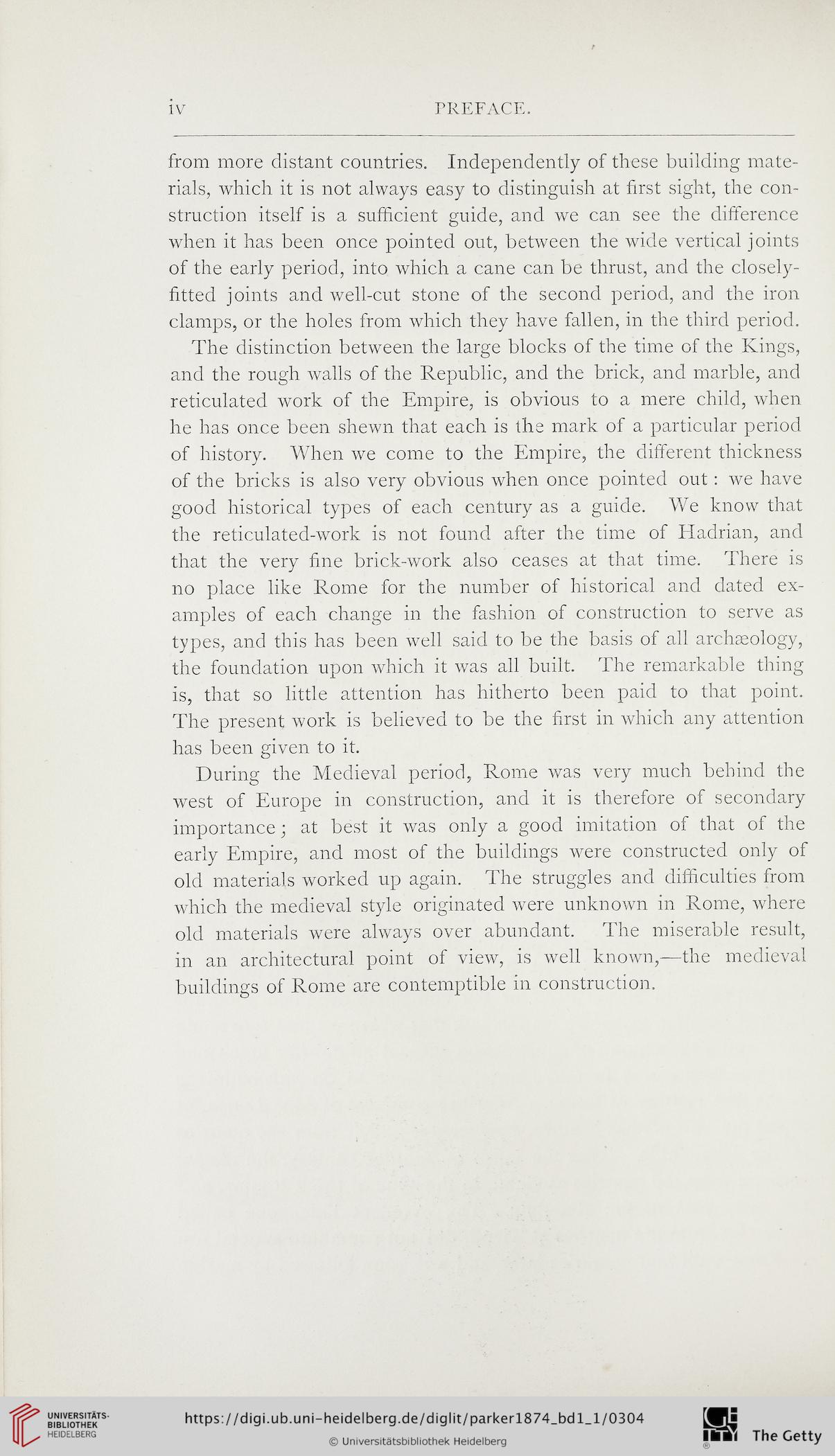IV
PREFACE.
from more distant countries. Independently of these building mate-
rials, which it is not always easy to distinguish at first sight, the con-
struction itself is a sufficient guide, and we can see the difference
when it has been once pointed out, between the wide vertical joints
of the early period, into which a cane can be thrust, and the closely-
fitted joints and well-cut stone of the second period, and the iron
clamps, or the holes from which they have fallen, in the third period.
The distinction between the large blocks of the time of the Kings,
and the rough walls of the Republic, and the brick, and marble, and
reticulated work of the Empire, is obvious to a mere child, when
he has once been shewn that each is the mark of a particular period
of history. When we come to the Empire, the different thickness
of the bricks is also very obvious when once pointed out: we have
good historical types of each century as a guide. We know that
the reticulated-work is not found after the time of Hadrian, and
that the very fine brick-work also ceases at that time. There is
no place like Rome for the number of historical and dated ex-
amples of each change in the fashion of construction to serve as
types, and this has been well said to be the basis of all archaeology,
the foundation upon which it was all built. The remarkable thing
is, that so little attention has hitherto been paid to that point.
The present work is believed to be the first in which any attention
has been given to it.
During the Medieval period, Rome was very much behind the
west of Europe in construction, and it is therefore of secondary
importance; at best it was only a good imitation of that of the
early Empire, and most of the buildings were constructed only of
old materials worked up again. The struggles and difficulties from
which the medieval style originated were unknown in Rome, where
old materials were always over abundant. The miserable result,
in an architectural point of view, is well known,—the medieval
buildings of Rome are contemptible in construction.
PREFACE.
from more distant countries. Independently of these building mate-
rials, which it is not always easy to distinguish at first sight, the con-
struction itself is a sufficient guide, and we can see the difference
when it has been once pointed out, between the wide vertical joints
of the early period, into which a cane can be thrust, and the closely-
fitted joints and well-cut stone of the second period, and the iron
clamps, or the holes from which they have fallen, in the third period.
The distinction between the large blocks of the time of the Kings,
and the rough walls of the Republic, and the brick, and marble, and
reticulated work of the Empire, is obvious to a mere child, when
he has once been shewn that each is the mark of a particular period
of history. When we come to the Empire, the different thickness
of the bricks is also very obvious when once pointed out: we have
good historical types of each century as a guide. We know that
the reticulated-work is not found after the time of Hadrian, and
that the very fine brick-work also ceases at that time. There is
no place like Rome for the number of historical and dated ex-
amples of each change in the fashion of construction to serve as
types, and this has been well said to be the basis of all archaeology,
the foundation upon which it was all built. The remarkable thing
is, that so little attention has hitherto been paid to that point.
The present work is believed to be the first in which any attention
has been given to it.
During the Medieval period, Rome was very much behind the
west of Europe in construction, and it is therefore of secondary
importance; at best it was only a good imitation of that of the
early Empire, and most of the buildings were constructed only of
old materials worked up again. The struggles and difficulties from
which the medieval style originated were unknown in Rome, where
old materials were always over abundant. The miserable result,
in an architectural point of view, is well known,—the medieval
buildings of Rome are contemptible in construction.




